
How high can birds fly? A Ruppell’s vulture was hit by a plane at 11,300 meters. The bird was identified by the feathers after the plane landed. There may be other birds that have flown higher, but they have not been encountered, so this is probably the record. There are three things that dictate the maximum height that birds can fly at. These are the temperature, the density of the air, and the amount of oxygen.
Birds can survive pretty low temperatures. They have several adaptations that help them. The first is that they are warm-blooded and they can make their own heat, so long as they have enough food. Many birds can survive sub zero temperatures if they can eat about 10% of their body mass in food. That is how much extra energy they need to stay warm. You can see it in Arctic explorers as well who plan on eating about 10,000 calories a day just because they need so much energy to stay warm. Secondly, birds have thick feathers that can be plumped up to keep heat in. Thirdly, birds have a circulation that is adapted to keep that heat in. The most likely place to lose heat is their feet, but their circulation is so fast that the blood doesn’t have time to chill in their feet and the cold blood coming back into the body is warmed by the warm blood going into the legs. Lastly, while flying they create a lot of heat by using their muscles. That being said, there is still a limit to the temperatures that they can survive. Generally, the temperature declines by an average of 8℃ for every 1000 meters of altitude. The temperature at 11,300 m, where the Ruppell’s vulture was found, would be about -56.5℃. Not many birds can survive this, but this vulture obviously can. The temperature above 11,000 m doesn’t go any lower, so the temperature wouldn’t be the limiting factor here.
That means it could be the oxygen that is the limiting factor. The amount of oxygen in the air decreases with altitude. At sea level, 20.9% of the air is oxygen, which is the amount we and most of the animals have evolved to need. If the amount of oxygen decreases, we all start to have problems. The amount of oxygen decreases by roughly 2% every 1,000 meters. At 5,000 meters it’s 11.2%. At 9,000 meters (a little over the height of Everest) it’s 6.8 %. At 11,300 meters, the oxygen is about 5%. Actually, that is not quite true. The makeup of the atmosphere is still 20% oxygen, even at those heights. The difference is the pressure. The pressure is so low that the atoms spread out, which means the amount of oxygen in the same volume of air is much lower and if we tried to breathe at that altitude, we would not get enough oxygen. That doesn’t seem to be a problem for the Ruppell’s vulture though. They have evolved a protein that absorbs and binds with oxygen very well. The birds can take in enough oxygen, even though it is scarce, and they can use what they have more efficiently. The birds regularly fly for hours every day and they glide on the thermals.
The last thing that will determine how high a bird can fly is the density of the air. Air pressure decreases with altitude, which is why the oxygen level decreases, but it also means there is less air for birds to push against. Birds get lift in the same way that planes do. There are three forces: lift, thrust, and drag. Lift is what lifts the bird into the air and it is created by pushing air over the wing faster than it goes under the wing, which creates an area of low pressure over the wing which lifts the wing, and the bird, up. Thrust is the power the bird has to have to make the air move over the wing and to move the bird forwards through the air. The bird gets this by flapping. Last is drag, which is the resistance from the air. Birds have to have enough thrust to overcome the drag so they can get lift. The higher up a bird goes, the thinner the air gets and the less lift there is. To be able to get enough lift, the bird needs more thrust. All planes have something called the service ceiling, which is the point where the plane can no longer get enough thrust to get lift. With birds, this depends on how big they are and how fast they can flap their wings. The Ruppell’s vulture is very strong and can flap its wings very hard. It also has very big wings which mean it can glide on the thermals. These two things mean it can get a lot more lift at higher altitudes than other birds can. However, the service ceiling for the Ruppell’s vulture must be at the 11,300 meter mark where one was seen because the air is just too thin for it to get any more lift. And that is what I learned today.
Photo by amy chung: https://www.pexels.com/photo/silhouette-of-bird-flying-672802/
Sources
https://en.wikipedia.org/wiki/R%C3%BCppell%27s_vulture
https://www.discoverwildlife.com/animal-facts/birds/how-high-do-birds-fly
https://education.nationalgeographic.org/resource/altitude
https://www.noaa.gov/jetstream/atmosphere/layers-of-atmosphere
https://www.onthesnow.com/news/does-elevation-affect-temperature
